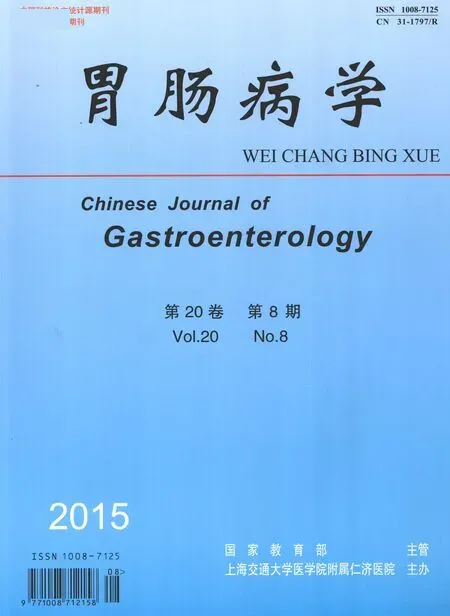内镜逆行胰胆管造影术后胰腺炎的研究进展
依尔潘·艾山 高 峰
新疆医科大学(830011)1 新疆维吾尔自治区人民医院消化科2
内镜逆行胰胆管造影术后胰腺炎的研究进展
依尔潘·艾山1高峰2*
新疆医科大学(830011)1新疆维吾尔自治区人民医院消化科2

胰腺炎是内镜逆行胰胆管造影术(endoscopic retrograde cholangiopancreatography, ERCP)的术后最常见并发症,发生率约为3%~5%[1]。Andriulli等[2]对16 855例患者研究发现,ERCP术后约3.5%的患者发生胰腺炎,0.4%为重度胰腺炎,其中0.11%发生死亡。ERCP术后胰腺炎(post-ERCP pancreatitis, PEP)的发生与多种因素相关。本文就PEP的研究进展作一综述。
一、PEP的诊断
PEP诊断标准:①ERCP术后持续腹痛;②血清淀粉酶>3倍标准值上限,持续>24 h;③延长住院时间>1 d。PEP的严重程度根据住院时间的长短以及是否需行干预措施决定。PEP的严重程度分为轻度(临床胰腺炎,血清淀粉酶>3倍正常值上限,持续>24 h,需将无针对性或针对性处理延长2~3 d)、中度(临床胰腺炎需住院治疗4~10 d)和重度(临床胰腺炎住院时间>10 d、出血性胰腺炎、胰腺坏死或假性囊肿、需行介入治疗如经皮引流或手术)[3]。
二、PEP发生的危险因素和保护因素
导致PEP的危险因素诸多,包括患者相关危险因素、内镜相关危险因素和手术相关危险因素,多种危险因素共存可发挥累积效应。年轻、女性、血清胆红素正常、曾在ERCP术后发生胰腺炎、Oddi括约肌功能障碍者发生PEP的风险较高[3]。Li等[4]的研究发现,服用胰毒性药物如雌激素、硫唑嘌呤、丙戊酸、美沙拉秦、吗啡衍生物以及泼尼松等可增加PEP的发生率。此外,内镜下插管困难、胰管注入造影剂、括约肌预切开术、胰管括约肌切开术、小乳头括约肌切开术、胆管支架术等亦是PEP发生的危险因素[3,5]。
研究[6-7]显示,吸烟、慢性肝脏疾病可降低PEP的发生率,是PEP的保护因素。
三、PEP的发生机制
PEP的发生机制:①乳头和胰管插管引起的机械性损伤;②使用电刀行胰胆管括约肌切开术时出现热损伤;③注射造影剂后进入胰管时或用0.9% NaCl溶液行括约肌测压时出现静水伤;④造影剂注射后进入胰管引起化学或过敏性损伤;⑤蛋白水解酶在胰管管腔内激活引起酶损伤;⑥由内镜及其配件引起的感染[8]。
四、PEP的预防
1. ERCP技术
①插管:使用导丝引导下插管术能降低胆管插管术的难度,但Kobayashi等[9]对322例患者采用导丝引导下胆管插管术或常规插管术,结果显示两组PEP发生率和胆管插管成功率相似。Mariani等[10]的研究显示,导丝引导下胆管插管术、胰管括约肌切开术以及注射造影剂三者引起PEP的概率无显著差异。在ERCP手术过程中,操作者应尽量减少插管次数、降低插管难度、避免插管所致的损伤,从而降低PEP的发生率。
②电灼:采用电刀行胆管或胰管括约肌切开术后的热损伤可引起PEP。有研究[11]对纯切电流与混合电流引起PEP的概率进行比较,结果显示纯切电流与混合电流行括约肌切开术的PEP发生率差异无统计学意义。尽量避免使用电刀行胆管或胰管括约肌切开术,以降低PEP的发生率。
③胰管支架:有报道[12]指出,对插管困难、针刀预切以及Oddi括约肌功能障碍患者行胆管括约肌切开术、胰腺括约肌切开术、内镜下壶腹切除以及内镜球囊扩张术后放置胰管支架可降低PEP的发生率以及严重程度。一项meta分析[13]对放置胰管支架与PEP发生率的相关性进行了分析,结果显示放置胰管支架组较未放置胰管支架组的PEP发生率显著降低。胰管支架带有一定的局限性,可发生胰管损伤、狭窄等并发症,此外,支架放置失败亦可发生胰腺炎。Freeman等[14]对225例ERCP高危患者进行前瞻性研究,3例患者胰管支架置入失败,其中2例(66.7%)发生胰腺炎,222例患者置入成功,其中32例(14.4%)发生胰腺炎。
②其他抗炎制剂:有研究[19]表明糖皮质激素可预防PEP,但有研究[20]指出预防性静脉注射或口服皮质类固醇不能降低PEP的发生率。白细胞介素-10(IL-10)是抗炎细胞因子。研究[21]发现,与安慰剂组(24%)相比,试验组ERCP术前30 min给予IL-10可显著降低PEP的发生率(8%),但Sherman等[22]的研究显示,与安慰剂相比,IL-10降低PEP发生率无显著优势。关于别嘌醇对PEP预防效果的研究结果亦存在矛盾。Bai等[23]的研究显示,别嘌醇不能降低PEP的发生率,不推荐作为预防剂。然而Hauser等[24]指出,ERCP术前3 h口服别嘌醇(600 mg)可显著降低PEP的发生率。
③减少胰腺分泌:生长抑素及其类似物是胰腺外分泌的强效抑制剂。Lee等[25]的研究发现,生长抑素有助于预防PEP。然而,Andriulli等[26]的研究显示生长抑素对预防PEP无明显效果。因此,目前不推荐生长抑素作为预防剂。降钙素在胰腺炎中的作用备受关注,但研究显示其对PEP无预防作用[27]。蛋白酶抑制剂可抑制参与急性胰腺炎炎症级联反应的胰蛋白酶活性。诸多研究对甲磺酸加贝酯、萘莫司他、乌司他丁预防PEP进行分析,但研究结果不尽一致。Seta等[28]进行的meta分析显示尚无确切证据证实蛋白酶抑制剂可预防PEP。
④抗菌药物和抗氧化剂:目前仅有一项前瞻性随机对照研究显示,ERCP术前30 min静脉给予头孢他啶可显著降低PEP的发生率,但由于此研究对照组未使用安慰剂而被认为质量较差[29]。因此,有关抗菌药物对PEP的预防作用仍需进一步研究。氧化应激可能参与PEP发病,但Gu等[30]的研究显示,与安慰剂相比,抗氧化剂在降低PEP发生率和严重程度方面无显著优势。
五、结语
总之,PEP是ERCP的常见并发症,可由多种因素导致。ERCP患者的选择和术前评估相关危险因素是预防PEP的关键。胰管支架对预防PEP起有一定作用,但具有局限性。NSAIDs直肠给药是降低PEP发生率的有效方式,已在临床广泛应用。其余药物预防PEP的结论尚不明确,有待后续进一步研究证实。
参考文献
1 Sakai Y, Tsuyuguchi T, Hirata N, et al. Can endoscopic sphincterotomy be performed safely in elderly patients aged 80 years or older with pancreatic and biliary diseases? [J]. Hepatogastroenterology, 2013, 60 (126): 1251-1256.
2 Andriulli A, Loperfido S, Napolitano G, et al. Incidence rates of post-ERCP complications: a systematic survey of prospective studies[J]. Am J Gastroenterol, 2007, 102 (8): 1781-1788.
3 Abdel Aziz AM, Lehman GA. Pancreatitis after endoscopic retrograde cholangio-pancreatography[J]. World J Gastroenterol, 2007, 13 (19): 2655-2668.
4 Li N, Tieng A, Novak S, et al. Effects of medications on postendoscopic retrograde cholangiopancreatography pancreatitis[J]. Pancreatology, 2010, 10 (2-3): 238-242.
5 Wilcox CM, Phadnis M, Varadarajulu S. Biliary stent placement is associated with post-ERCP pancreatitis[J]. Gastrointest Endosc, 2010, 72 (3): 546-550.
6 DiMagno MJ, Spaete JP, Ballard DD, et al. Risk models for post-endoscopic retrograde cholangiopancreatography pancreatitis (PEP): smoking and chronic liver disease are predictors of protection against PEP[J]. Pancreas, 2013, 42 (6): 996-1003.
7 Glomsaker T, Hoff G, Kvaløy JT, et al. Patterns and predictive factors of complications after endoscopic retrograde cholangiopancreatography[J]. Br J Surg, 2013, 100 (3): 373-380.
8 Donnellan F, Byrne MF. Prevention of post-ERCP pancreatitis[J]. Gastroenterol Res Pract, 2012, 2012: 796751.
9 Kobayashi G, Fujita N, Imaizumi K, et al. Wire-guided biliary cannulation technique does not reduce the risk of post-ERCP pancreatitis: multicenter randomized controlled trial[J]. Dig Endosc, 2013, 25 (3): 295-302.
10Mariani A, Giussani A, Di Leo M, et al. Guidewire biliary cannulation does not reduce post-ERCP pancreatitis compared with the contrast injection technique in low-risk and high-risk patients[J]. Gastrointest Endosc, 2012, 75 (2): 339-346.
11Verma D, Kapadia A, Adler DG. Pure versus mixed electro-surgical current for endoscopic biliary sphincterotomy: a meta-analysis of adverse outcomes[J]. Gastrointest Endosc, 2007, 66 (2): 283-290.
12Feurer ME, Adler DG. Post-ERCP pancreatitis: review of current preventive strategies[J]. Curr Opin Gastroenterol, 2012, 28 (3): 280-286.
13Mazaki T, Mado K, Masuda H, et al. Prophylactic pancreatic stent placement and post-ERCP pancreatitis: an updated meta-analysis[J]. J Gastroenterol, 2014, 49 (2): 343-355.
14Freeman ML, Overby C, Qi D. Pancreatic stent insertion: consequences of failure and results of a modified technique to maximize success[J]. Gastrointest Endosc, 2004, 59 (1): 8-14.
15Murray B, Carter R, Imrie C, et al. Diclofenac reduces the incidence of acute pancreatitis after endoscopic retrograde cholangiopancreatography[J]. Gastroenterology, 2003, 124 (7): 1786-1791.
16Elmunzer BJ, Waljee AK, Elta GH, et al. A meta-analysis of rectal NSAIDs in the prevention of post-ERCP pancreatitis[J]. Gut, 2008, 57 (9): 1262-1267.
17Dai HF, Wang XW, Zhao K. Role of nonsteroidal antiin-flammatory drugs in the prevention of post-ERCP pancreatitis: a meta-analysis[J]. Hepatobiliary Pancreat Dis Int, 2009, 8 (1): 11-16.
18Ding X, Chen M, Huang S, et al. Nonsteroidal anti-inflammatory drugs for prevention of post-ERCP pancreatitis: a meta-analysis[J]. Gastrointest Endosc, 2012, 76 (6): 1152-1159.
19Kahaleh M, Freeman M. Prevention and management of post-endoscopic retrograde cholangiopancreatography complications[J]. Clin Endosc, 2012, 45 (3): 305-312.
20Law R, Leal C, Dayyeh BA, et al. Role of immunosuppression in post-endoscopic retrograde cholangiopancreatography pancreatitis after liver transplantation: a retrospective analysis[J]. Liver Transpl, 2013, 19 (12): 1354-1360.
21Dumot JA, Conwell DL, Zuccaro G, et al. A randomized, double blind study of interleukin 10 for the prevention of ERCP-induced pancreatitis[J]. Am J Gastroenterol, 2001, 96 (7): 2098-2102.
22Sherman S, Cheng CL, Costamagna G, et al. Efficacy of recombinant human interleukin-10 in prevention of post-endoscopic retrograde cholangiopancreatography pancreatitis in subjects with increased risk[J]. Pancreas, 2009, 38 (3): 267-274.
23Bai Y, Gao J, Zhang W, et al. Meta-analysis: allopurinol in the prevention of postendoscopic retrograde cholangio-pancreatography pancreatitis[J]. Aliment Pharmacol Ther, 2008, 28 (5): 557-564.
24Hauser G, Milosevic M, Stimac D, et al. Preventing post-endoscopic retrograde cholangiopancreatography pancreatitis: what can be done?[J]. World J Gastroenterol, 2015, 21 (4): 1069-1080.
25Lee KT, Lee DH, Yoo BM. The prophylactic effect of somatostatin on post-therapeutic endoscopic retrograde cholangiopancreatography pancreatitis: a randomized, multicenter controlled trial[J]. Pancreas, 2008, 37 (4): 445-448.
26Andriulli A, Leandro G, Federici T, et al. Prophylactic administration of somatostatin or gabexate does not prevent pancreatitis after ERCP: an updated meta-analysis[J]. Gastrointest Endosc, 2007, 65 (4): 624-632.
27Freeman ML. Complications of endoscopic retrograde cholangiopancreatography: avoidance and management[J]. Gastrointest Endosc Clin N Am, 2012, 22 (3): 567-586.
28Seta T, Noguchi Y. Protease inhibitors for preventing complications associated with ERCP: an updated meta-analysis[J]. Gastrointest Endosc, 2011, 73 (4): 700-706.
29Vila JJ, Artifon EL, Otoch JP. Post-endoscopic retrograde cholangiopancreatography complications: How can they be avoided? [J]. World J Gastrointest Endosc, 2012, 4 (6): 241-246.
30Gu WJ, Wei CY, Yin RX. Antioxidant supplementation for the prevention of post-endoscopic retrograde cholangio-pancreatography pancreatitis: a meta-analysis of randomized controlled trials[J]. Nutr J, 2013, 12: 23.
(2015-01-05收稿;2015-03-04修回)
(2014-12-14收稿; 2015-02-23修回)
摘要胰腺炎是内镜逆行胰胆管造影术(ERCP)的术后常见并发症。ERCP患者的选择和术前评估相关危险因素是预防ERCP术后胰腺炎(PEP)的关键。胰管支架对预防PEP有一定作用,但具有局限性。NSAIDs直肠给药是降低PEP发生率的有效方式。其余药物预防PEP的结论尚不明确。本文就PEP的研究进展作一综述。
关键词胰腺炎;胰胆管造影术, 内窥镜逆行;危险因素;预防
Advances in Study on Post-endoscopic Retrograde Cholangiopancreatography PancreatitisYIERPANAishan1,GAOFeng2.1XinjiangMedicalUniversity,Urumqi(830011);2DepartmentofGastroenterology,People’sHospitalofXinjiangUygurAutonomousRegion,Urumqi
Correspondence to: GAO Feng, Email: xjgf@sina.com
AbstractPancreatitis is a common complication of endoscopic retrograde cholangiopancreatography (ERCP). Patient selection and risk factors assessment are critical elements for preventing post-ERCP pancreatitis (PEP). Pancreatic stent plays a role in prevention of PEP, but with limitations. Rectal administration of NSAIDs is an effective way to reduce the incidence of PEP. Effect of other drugs for preventing PEP is unclear. This article reviewed the advances in study on PEP.
Key wordsPancreatitis;Cholangiopancreatography, Endoscopic Retrograde;Risk Factors;Prevention
通信作者*本文,Email: xjgf@sina.com
DOI:10.3969/j.issn.1008-7125.2015.08.015

